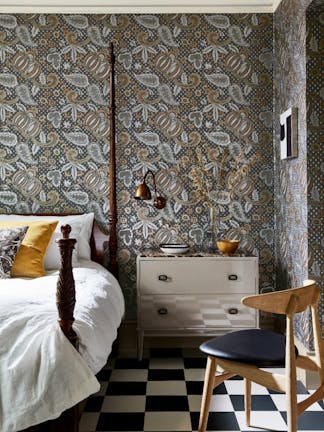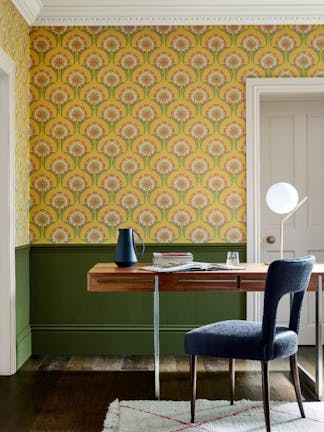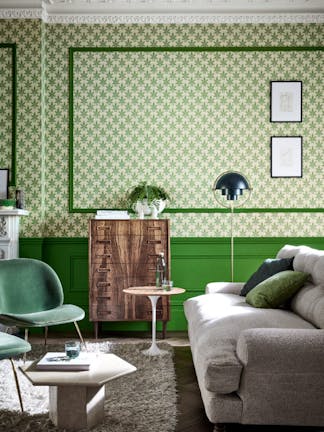
National Trust Papers wallpaper collection
Little Greene launches its latest collaborative project, National Trust Papers – a diverse collection of contemporary wallpapers based on original patterns from the National Trust's venerable portfolio of properties.
Little Greene has been working with the National Trust since January 2018. The first collaborative project, Green, focused on 20 original colors sourced from National Trust homes and gardens across England, Wales and Northern Ireland. The joint project has proven so successful that it has now been expanded to include wallpaper. The “National Trust Papers” collection will be launched at the Paris Déco-Off in January 2020.

‘Pavona’ (Erddig) c. 1875
This extravagant, vibrant peacock design is a beautiful example of late 19th century wallpaper printing. Found on a wall of a lobby at Erddig Hall in Wales, it was installed there in the 1870s and has the painterly finish of traditional Chinese silk. The pattern features peacocks on branches as well as flowers, leaves and other birds and is typical of wallpapers and fabrics made for the Western elite and their enthusiasm for Chinese design. This wallpaper is available in eight vibrant colorways, including elegant pale and more intensely colored, with a dark base and even shimmering gold.

‘Belton Scenic’ (Belton House) c. 1785
The much admired original of this wallpaper can be found in the Chinese bedroom of Belton House in Lincolnshire. While the wallpaper itself is significantly older, the garden party scene with a combination of printed and hand-painted elements is known to date from 1785 and was installed more than 50 years later in 1840.
The original includes people, exotic birds, a special perspective and extraordinary details. The modern interpretation has been simplified to give more space to the spreading bamboo and the charming interaction between birds, butterflies and flowers. The horizontal pattern, produced digitally and available in three colors, is repeated across two standard rolls, i.e. just over three meters wide.

‘Pomegranate’ (Erddig) c. 1715
This Baroque design is a rare and very early find, discovered by the National Trust among tapestries at Erddig Hall in Wales. It was printed in blocks onto handmade paper panels that were nailed directly to the wall (rather than gluing them); When they were removed, the oldest verified tax stamp was found on the back.
The colorful yellow original has been slimmed down into four colorways. Three additional color combinations ensure that this cheerful paisley design can also be used in a variety of ways in modern interiors.

‘Achillea’ (Felbrigg Hall) c. 1910
This was originally just a border, a fragment of which is preserved at Felbrigg Hall, Norfolk; however, the size of the pattern was completely changed. With its shadowy stems and flower heads of yarrow or possibly the locally common swamp sow thistle, this is a classic example of Art Nouveau; the color areas are typical of screen printed designs. In addition to a radical change in the pattern size and the digital printing of the design, the five modern, impressively coordinated color combinations of “Achillea” ensure that it is suitable both as a background and as an eye-catcher in modern rooms.

‘Stag Trail’ (Greyfriars House and Garden) c. 1720
This classic Georgian design can be admired at Greyfriars, a medieval wooden house in Worcester. Elsie Moore, a 20th-century owner of the property, purchased some unused scrolls from a parish in nearby Pershore and displayed cut-outs from them as framed panels in her pale yellow dining room. Suspecting that the turquoise pigment in the background might contain arsenic, she wrapped the panels in plain wrapping paper to avoid accidentally poisoning herself and her guests. The holes from the nails she used are still visible today, but the wallpaper is now, thankfully – and risk-free – displayed again.
Buy wallpaper now
The scale of the original wallpaper has been reduced for ease of use, while the four colorways include a homage to the original, a traditional interpretation as well as more modern options.

‘Hencroft’ c.1890
The extensive work of William Morris and his Arts & Crafts Movement is well documented in the National Trust's portfolio, not least in his own home, the Red House in London. He was a visitor, “student” and 19th century influencer, so to speak, at Hencroft Works in Leek, where his friend Thomas Wardle taught and experimented with dyeing fabrics and wallpapers with natural inks. This design - an embroidered repeating pattern with stylized cowslips - was discovered at Wardle's sewing school in Leek and effortlessly translated into a wallpaper design in eight stunning colorways.

‘Clutterbuck’ (Newark Park) c. 1805
Built by a courtier of Henry VIII in the Cotswolds, Newark Park is a Tudor-style hunting lodge; unfortunately only a fragment of this design with small leaves remains. The simple pattern featured two shades of green on a semi-gloss white background, creating the illusion of a woven fabric; Interestingly, it was adapted from wallpaper from the clock tower at Hampton Court Palace. The design takes its name from James Clutterbuck, who acquired Newark Park in the mid-18th century, although the wallpaper dates from the early 19th century. Five modern colorways include more delicate contrasts and bolder primary shades on matte white, reflecting the impact of the original design.

The collection includes 40 colorways in seven designs and represents 200 years of timeless patterns from the early 18th to early 20th centuries. Each wallpaper has been recreated based on originals from National Trust properties across the country. These originals include wallpaper that still adorns the ancient walls, fragments stored in archive drawers, and even surviving rolls of wallpaper found in the back of an attic.
